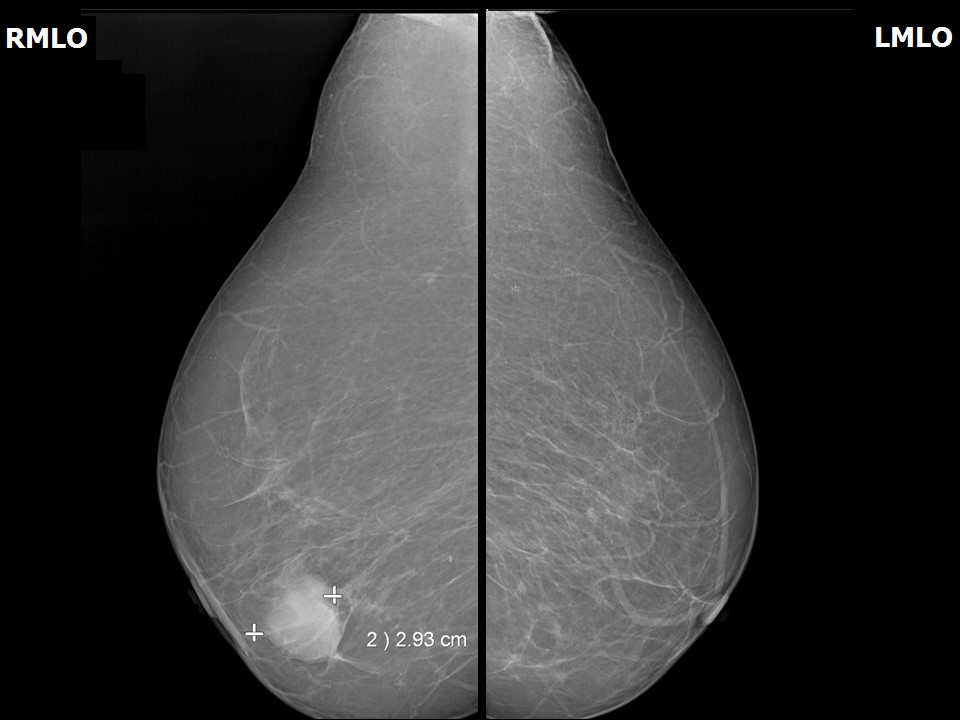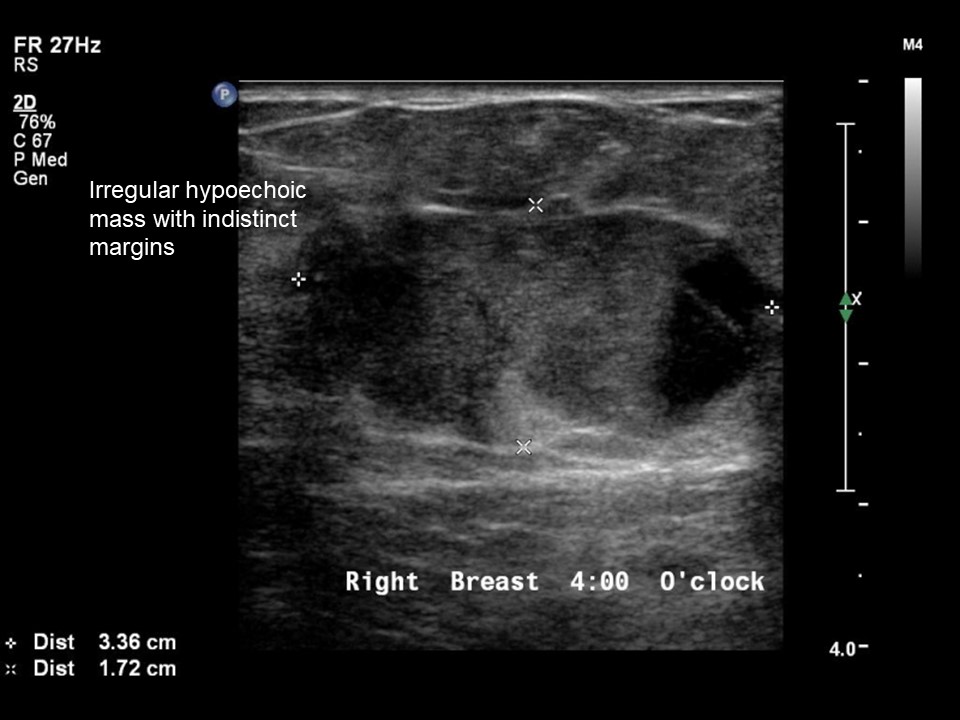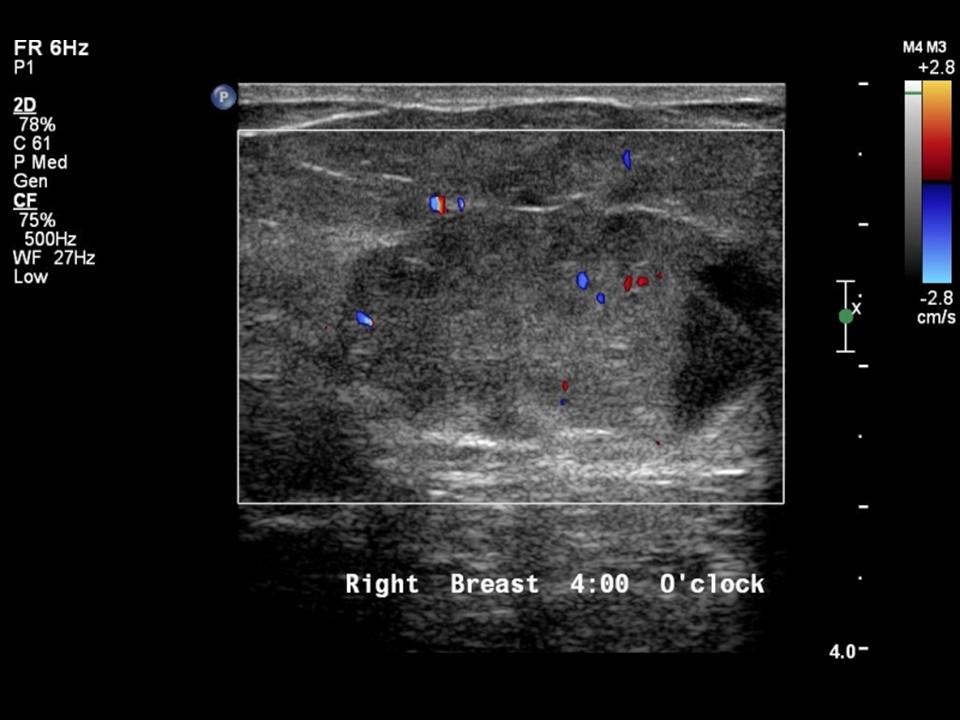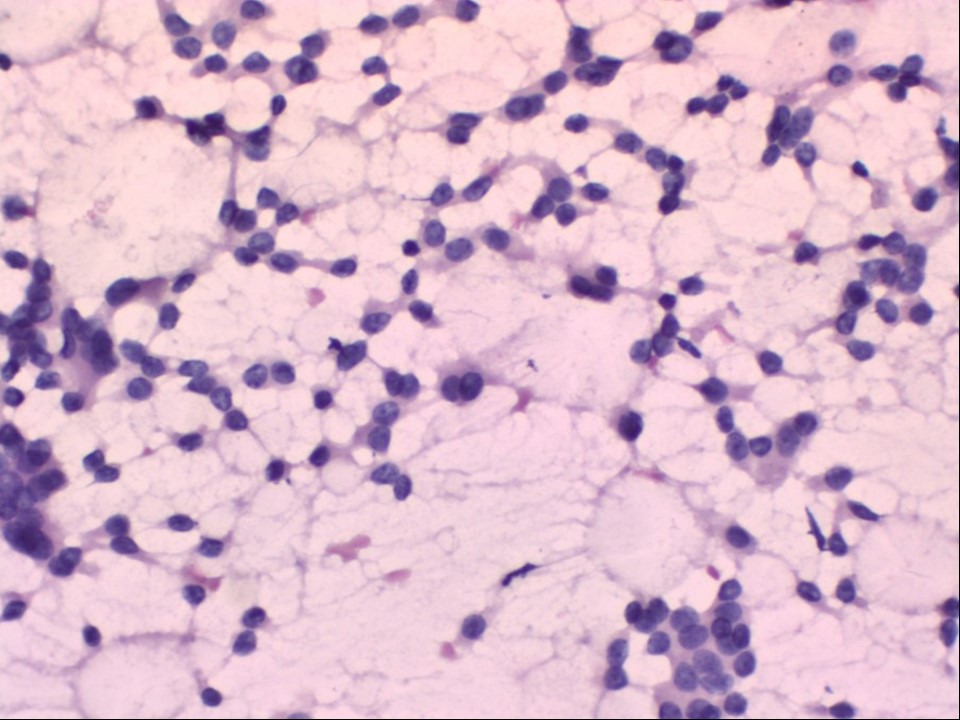Home / Training / Manuals / Atlas of breast cancer early detection / Cases
Atlas of breast cancer early detection
Filter by language: English / Русский
Go back to the list of case studies
.png) Click on the pictures to magnify and display the legends
Click on the pictures to magnify and display the legends
| Case number: | 050 |
| Age: | 66 |
| Clinical presentation: | Postmenopausal woman with average risk of developing breast cancer presented with a lump in the right breast. Examination revealed a hard 3 cm lump in the right lower quadrant extending into the retroareolar region. Lymph nodes in the axillae were palpable on the right side. |
Mammography:
| Breast composition: | ACR category a (the breasts are almost entirely fatty) | Mammography features: |
| ‣ Location of the lesion: | Right breast, lower inner quadrant at 4–5 o’clock, anterior third |
| ‣ Mass: | |
| • Number: | 1 |
| • Size: | 3.5 × 3.0 cm |
| • Shape: | Irregular |
| • Margins: | Indistinct |
| • Density: | High |
| ‣ Calcifications: | |
| • Typically benign: | None |
| • Suspicious: | None |
| • Distribution: | None |
| ‣ Architectural distortion: | None |
| ‣ Asymmetry: | None |
| ‣ Intramammary node: | None |
| ‣ Skin lesion: | None |
| ‣ Solitary dilated duct: | None |
| ‣ Associated features: | Skin thickening and skin retraction |
Ultrasound:
| Ultrasound features: Right breast, lower inner quadrant at 4–5 o’clock | |
| ‣ Mass | |
| • Location: | Right breast, lower inner quadrant at 4–5 o’clock |
| • Number: | 1 |
| • Size: | 3.4 × 1.7 cm |
| • Shape: | Irregular |
| • Orientation: | Not parallel |
| • Margins: | Indistinct |
| • Echo pattern: | Heteroechoic |
| • Posterior features: | No posterior features |
| ‣ Calcifications: | None |
| ‣ Associated features: | Internal vascularity |
| ‣ Special cases: | None |
BI-RADS:
BI-RADS Category: 5 (highly suggestive of malignancy)Further assessment:
Further assessment advised: Referral for cytologyCytology:
| Cytology features: | |
| ‣ Type of sample: | FNAC |
| ‣ Site of biopsy: | |
| • Laterality: | Right |
| • Quadrant: | Lower inner |
| • Localization technique: | Palpation |
| • Nature of aspirate: | whitish |
| ‣ Cytological description: | Smears are very cellular and show dyscohesive sheets of malignant ductal cells with single isolated malignant cells. A few cohesive benign ductal cells are also present |
| ‣ Reporting category: | Malignant |
| ‣ Diagnosis: | Carcinoma |
| ‣ Comments: | None |
Histopathology:
MRM
| Histopathology features: | |
| ‣ Specimen type: | MRM |
| ‣ Laterality: | Right |
| ‣ Macroscopy: | On serial sectioning, a tumour (3.5 × 1.5 × 3.0 cm) is identified in the upper and lower medial quadrant near the areola. It is located 2.0 cm below the skin and 2.5 cm from the base. The cut surface of the tumour is firm and greyish white with haemorrhagic areas |
| ‣ Histological type: | Invasive breast carcinoma with neuroendocrine differentiation |
| ‣ Histological grade: | Grade 2 (3 + 2 + 1 = 6) |
| ‣ Mitosis: | 4 |
| ‣ Maximum invasive tumour size: | 3.5 cm in greatest dimension |
| ‣ Lymph node status: | 0/9 |
| ‣ Peritumoural lymphovascular invasion: | Absent |
| ‣ DCIS/EIC: | A few foci of cribriform DCIS of low grade |
| ‣ Margins: | Free of tumour, closest radial margin is skin at 2.0 cm |
| ‣ Pathological stage: | pT2N0 |
| ‣ Biomarkers: | ER positive, PR positive |
| ‣ Comments: | IHC of tumour for synaptophysin, chromogranin A, and neuron-specific enolase is confirmatory for neuroendocrine differentiation |
Case summary:
| Postmenopausal woman presented with right breast lump. Diagnosed as right breast carcinoma BI-RADS 5 on imaging, as breast carcinoma on cytology, and as invasive breast carcinoma with neuroendocrine differentiation, pT2N0 on histopathology. |
Learning points:
|









